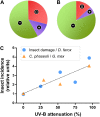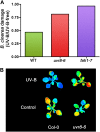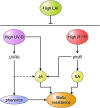Canopy light and plant health
- PMID: 22802612
- PMCID: PMC3440192
- DOI: 10.1104/pp.112.200733
Canopy light and plant health
Figures





References
-
- A-H-Mackerness S, Surplus SL, Blake P, John CF, Buchanan-Wollaston V, Jordan BR, Thomas B. (1999) Ultraviolet-B-induced stress and changes in gene expression in Arabidopsis thaliana: role of signalling pathways controlled by jasmonic acid, ethylene and reactive oxygen species. Plant Cell Environ 22: 1413–1423
-
- Agrawal A, Kearney E, Hastings A, Ramsey T. (2012) Attenuation of the jasmonate burst, plant defensive traits, and resistance to specialist monarch caterpillars on shaded common milkweed (Asclepias syriaca). J Chem Ecol 38: 893–901 - PubMed
-
- Agrawal AA, Heil M. (2012) Synthesizing specificity: multiple approaches to understanding the attack and defense of plants. Trends Plant Sci 17: 239–242 - PubMed
-
- Albrecht C, Boutrot F, Segonzac C, Schwessinger B, Gimenez-Ibanez S, Chinchilla D, Rathjen JP, de Vries SC, Zipfel C. (2012) Brassinosteroids inhibit pathogen-associated molecular pattern-triggered immune signaling independent of the receptor kinase BAK1. Proc Natl Acad Sci USA 109: 303–308 - PMC - PubMed
-
- Alexander HM, Holt RD. (1998) The interaction between plant competition and disease. Perspect Plant Ecol Evol Syst 1: 206–220
Publication types
MeSH terms
Substances
LinkOut - more resources
Full Text Sources
Other Literature Sources

